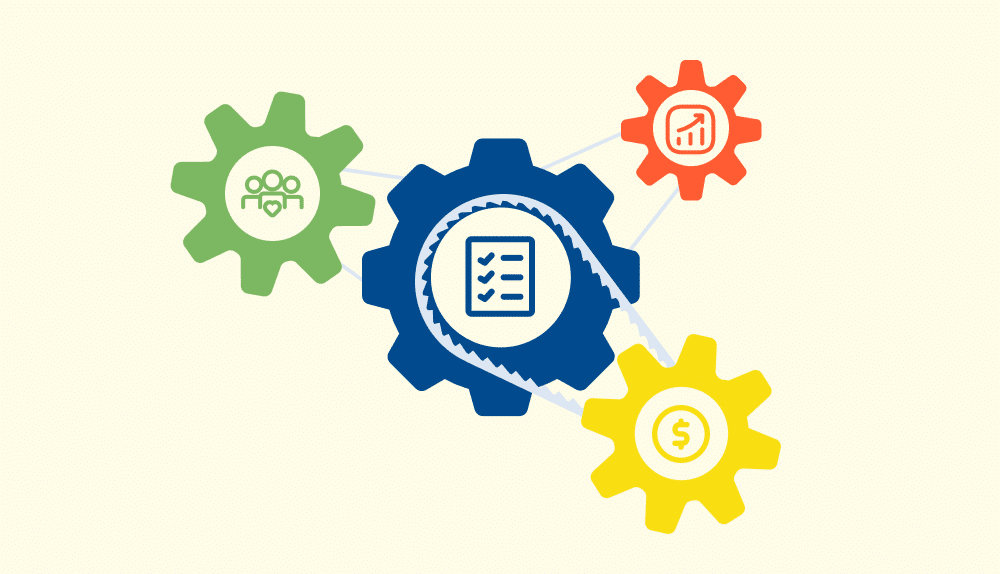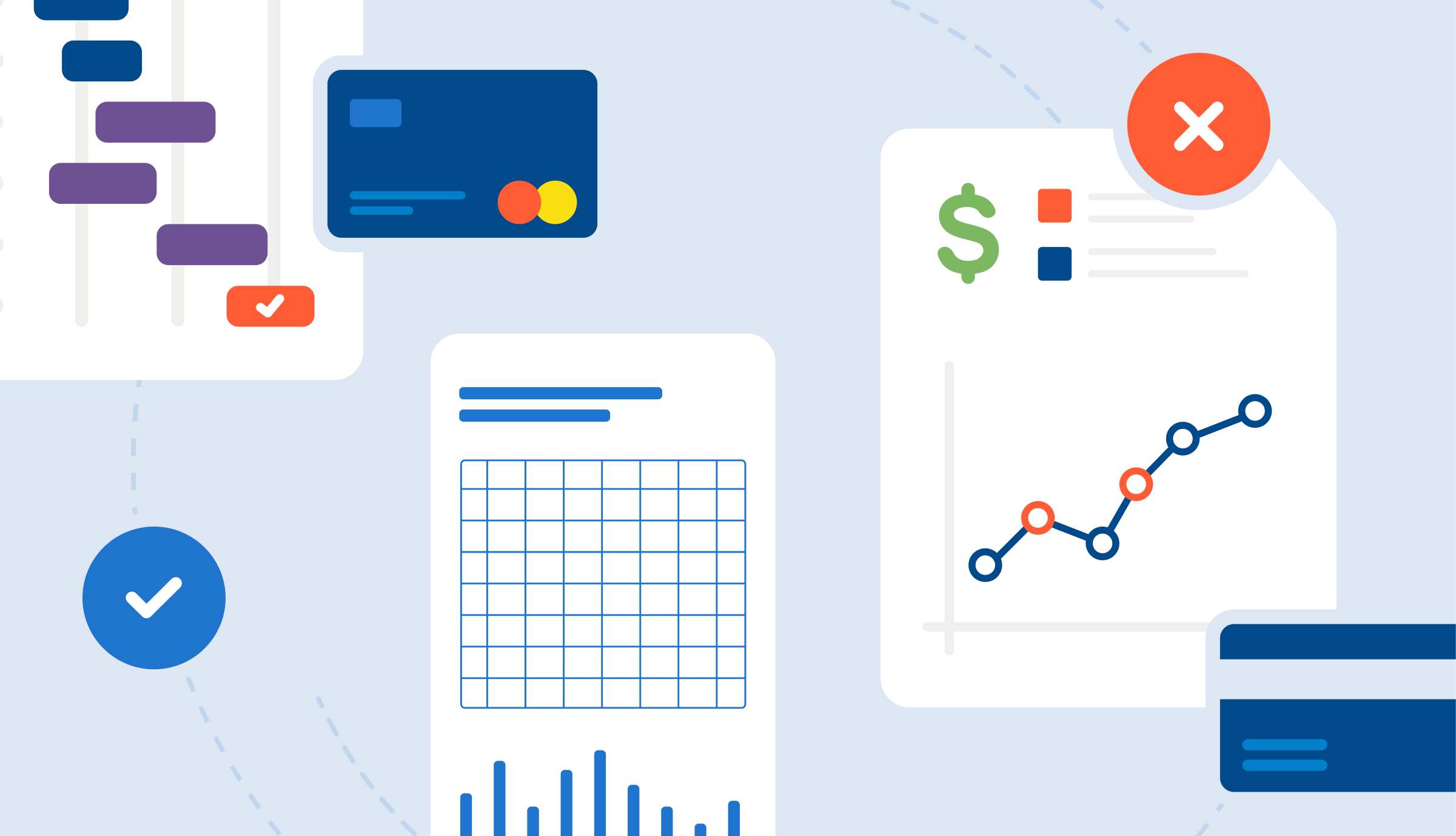While obvious, successful project delivery is key to a professional services organization’s success and profitability. However, achieving it isn’t always as straightforward. One of the biggest drivers for having successful project delivery is having teams well aligned, particularly — finance, sales, and delivery teams. To do so, professional services businesses should establish a singular source of truth, ensuring teams work together seamlessly. In doing so, organizations empower their teams to make informed decisions, mitigate the risk of miscommunication, and streamline time-consuming processes to achieve successful and repeatable project delivery.
In this article, we’ll discuss how organizations can create this single source of information and the benefits it brings.
Disjointed Systems are Working Against You: Ineffective Project Delivery Methods
Using outdated methods and relying on spreadsheets can create countless obstacles. These approaches often lead to confusion, errors, and limited collaboration. Below we outline some of those challenges you’re probably all too familiar with if you’re using a disjointed system like spreadsheets or relying on several different tools.
Information Disparities Impact Different Teams
Effective project delivery relies on seamless information flow, yet disparities across teams can lead to confusion and hinder progress. Misaligned information can compromise the cohesiveness of project teams, impacting decision-making and overall project success.
Inaccurate Resource Availability Cause Scope Creep and Budget Overruns
Checking resource availability without real-time confirmation poses a significant risk of project delays. The lack of accurate, up-to-date information on resource availability can lead to misjudgments in planning and execution, potentially resulting in resource conflicts, bottlenecks, and disruptions to project timelines. This not only impacts the overall efficiency of project management but also introduces the potential for increased costs and client dissatisfaction.
Unreliable Data Results in Unreliable Forecasting
The absence of a unified view of resources and finances can severely impact budgeting and long-term planning. Finance teams face challenges in providing accurate forecasts and projections without comprehensive oversight. Recognizing the importance of a unified view is essential for effective financial planning and ensuring the success of projects in the long run.

The Syncing Power of Resource Management Software: Bringing Teams Together
Now it’s time to get into what’s really important — the solution. Resource management software acts like a team unifier, bringing everything (and everyone) together in one place. It syncs teams by centralizing resource management, providing real-time visibility and easy communication. This creates a stable working environment where everyone stays on the same page about resources and project details.
In this section, we’ll show you how to harness the syncing power of resource management software to enhance teamwork, optimize resource use, and enhance overall project delivery success.
Seamless Sales-to-Project Handoff: Client expectations and project requirements are clear to all teams, improving the execution and reducing the need for costly revisions.
For sales, the efficient transfer of client details and project specifications to the delivery team via resource management software ensures that client preferences and expectations are accurately conveyed. This lays the groundwork for transparent communication and lasting client satisfaction.
In this step, the delivery team serves as consultants to the sales team during client handoff, providing valuable insights on realistic plans and expectations. This ensures that the sales team doesn’t oversell services or create false expectations, leading to better alignment between client expectations and actual deliverables.
With access to real-time data and historical project information, the sales team can provide informed recommendations and guidance to ensure a smoother transition from sales to project delivery. For the delivery team, being aware of accurate client expectations ensures an informed execution of project tasks.
How resource management software creates a smooth sales-to-project handoff:
- Seamlessly transfers client details, project specifications, and relevant documentation from sales to delivery teams.
- Ensures that client preferences, expectations, and any specific requirements are clearly communicated and understood by the project delivery team.
- Enables all teams to forecast resource needs for upcoming projects, preventing overallocation or bottlenecks. This includes assessing the balance between supply and demand, determining when additional hiring might be necessary to meet incoming deal demands, and identifying available staff members who can be allocated to new client projects.
- Makes sure that all relevant information is stored in one location, reducing the risk of miscommunication or data loss during handoff.
- Provides real-time updates on project progress, resource availability, and any changes in project scope. Sales teams can access the latest information.
- Maintains a consistent level of service for the client experience from the sales phase to the project delivery phase, fostering trust and satisfaction.
- Forecasts resource requirements by leveraging insights from the pipeline, enabling proactive planning and resource allocation.
- Utilizes historical project data to accurately estimate costs and price future projects, ensuring competitiveness and profitability.
Centralized Resource Allocation: Finance, sales, and delivery teams work in one system for reliable insights into utilization and availability, keeping projects on track and profitable.
Simple and up-to-date resource allocation is crucial for successful projects, ensuring the right resources are utilized at the right time. It not only keeps everything on track but also helps in assessing bandwidth for potential new clients and managing the project pipeline.
Resource management software simplifies the allocation process by providing a centralized platform for finance, sales, and delivery teams to coordinate efforts and align with project goals. This prevents delays and optimizes timelines by streamlining communication and ensuring everyone has real-time visibility into resource availability.
The software also allows you to match resources based on skills and expertise, ensuring the right capabilities are allocated to meet specific project requirements. By enhancing resource utilization in this way, it significantly increases the likelihood of successful project delivery, fostering effective collaboration and timely project completion.
How resource management software keeps resource allocation centralized:
- Ensures that all teams have a consolidated view of available resources, preventing discrepancies in resource information.
- Enhances communication and coordination among teams to align resource allocation decisions with project objectives.
- Helps finance teams keep a pulse on budget constraints and financial implications.
Accurate Project Insights: Empowers teams to quickly spot and address issues, make informed decisions based on the latest project developments, and respond promptly to changing requirements or external factors through instant access to project analytics.
Resource management software plays a pivotal role in ensuring accurate project insights and synchronizing finance, sales, and delivery teams throughout the project lifecycle. For sales, real-time updates on project milestones and challenges empower proactive client communication, fostering transparency and satisfaction. In delivery, these insights enable efficient task navigation and prompt problem resolution, ensuring smooth transitions and positive client experiences. Finance teams also benefit by making informed pricing decisions with access to historical project data, aligning budgets with past performance. This interconnected approach not only enhances individual team efficiency but also fosters a synchronized workflow, promoting seamless communication and collaboration across sales, delivery, and finance teams.
How resource management software keeps project insights accurate::
- Reduces delays and miscommunications during the handoff process, leading to smoother transitions and client satisfaction for the sales team.
- Fosters a shared understanding of project goals, timelines, and resource allocation.
- Ensures everyone is working with the latest information, promoting accuracy in decision-making and reducing the risk of errors due to outdated information.
- Enables finance teams to accurately plan budgets based on current resource utilization, while delivery teams can adjust project timelines and tasks dynamically.
Unified Utilization: Sales, finance, and delivery can forecast with accuracy to optimize project profitability.
Aligning finances to the measurement of utilization allows you to make projects more profitable and increase the accuracy of your forecasting. It ensures transparent client communication for sales and provides finance with precise budgeting insights. Streamlining task management aligns project timelines with financial goals. Additionally, simplified time tracking accelerates the invoicing process, keeping project and finance teams in sync and minimizing delays in financial workflows. This all leads to optimized resource allocation, controlled costs, and enhanced forecasting, leading to increased project profitability and success.
How resource management software keeps utilization unified:
- Provides a centralized platform for finance, sales, and delivery teams to collaborate on unified utilization data, fostering a cohesive approach to project planning.
- Enhances communication and coordination, ensuring financial decisions are aligned with project objectives.
- Utilizes analytics to identify potential financial risks associated with resource utilization, enabling proactive measures to mitigate them.

Proactive Risk Management: Improved transparency and collaboration allow sales, finance, and delivery teams to quickly spot and solve challenges for continued success.
Resource management software provides a platform for collaborative risk management among sales, finance, and delivery teams. It enhances visibility, facilitates informed decision-making, and ensures proactive measures are taken to address challenges, improving the project delivery process.
By leveraging historical project data and analytics, the software informs gut checks, risk assessments, and identifies patterns and lessons learned. It enables teams to conduct scenario planning based on identified risks, allowing them to anticipate various outcomes and develop contingency plans to address potential challenges. This proactive approach not only improves communication and transparency among teams regarding identified risks and mitigation plans but also supports continuous monitoring throughout the project lifecycle.
How resource management software keeps risk management proactive:
- Supports continuous monitoring of risks throughout the project lifecycle.
- Enhances visibility into risk factors, allowing teams to adapt strategies promptly and mitigate potential issues.
- Enables teams to conduct scenario planning based on identified risks.
- Helps teams anticipate various outcomes and develop contingency plans to address potential challenges.
- Improve transparency among teams regarding identified risks and mitigation plans.
Achieve Project Delivery Excellence with BigTime Foresight
When it comes to choosing resource management software, it’s important to choose one that’s simple to use but works to solve complex problems for your organization. BigTime Foresight does just that. Helping to align sales, delivery, and finance teams, BigTime Foresight works hard to drive successful project delivery through the following features and benefits.
Balance Your Teams’ Workloads
Empower your organization to dynamically balance team workloads with the capability to tie utilization plans to financial impact. Strategically manipulate cost rates, leverage ratios, and projects to ensure optimal profitability. Utilize soft allocation to efficiently plan resources, preventing overallocation and maintaining a harmonized workload distribution.
Model Profitable Growth Scenarios
Compare project plans to service delivery goals using automated budget creation and long-term forecast visualization. BigTime Foresight enables your teams to understand how various resource plans impact finances, fostering informed decision-making and promoting sustained growth and profitability.
Bring Teams Together
Facilitate collaboration among delivery, finance, and sales teams using real-time insights. This enables seamless communication, precise resource allocation, and proactive planning for market demand, improving client satisfaction and enhancing project delivery success.
Create a Single Source of Truth
Centralize resource management with a unified view of resource availability, creating a single source of truth. Ensure that finance, sales, and delivery teams stay in sync with live reporting, providing clarity and control over resource allocation. Streamline operations, prevent conflicts, and make data-driven decisions for successful project delivery.

Frequently Asked Questions About Successful Project Delivery
What does a successful project delivery look like?
Successful project delivery involves meeting stakeholder expectations, finishing tasks on time and within budget, achieving project goals, and ensuring quality outcomes through effective resource management. It requires clear communication, collaboration, and efficient resource allocation following project management best practices.
How do you measure project delivery success?
Project delivery success is measured by assessing whether the project meets or exceeds stakeholder expectations, stays within the allocated budget and timeline, and achieves its predefined objectives. Additionally, evaluating the quality of outcomes and the satisfaction of stakeholders are crucial indicators of project success.
What drives project delivery?
Project delivery is driven by effective planning, clear communication, and efficient execution. Successful projects depend on a combination of skilled team collaboration, adherence to timelines, and proactive problem-solving to achieve their objectives.
What is the role of resource management in project delivery?
Resource management in project delivery involves efficiently allocating and utilizing available resources, such as time, budget, and personnel, to ensure tasks are completed within the designated constraints. It plays a crucial role in optimizing project performance, maintaining cost-effectiveness, and meeting overall project goals.
How do you manage resources to deliver a project?
To manage resources efficiently for project delivery, use resource management software to identify project requirements, allocate tasks based on team members’ strengths, and monitor progress regularly. Utilize the software’s features for real-time collaboration, communication, and data analysis to optimize resource utilization, ensuring tasks are completed efficiently within the set timeframe and budget.
How does resource management impact project success?
Effective resource management significantly impacts project success by ensuring optimal allocation of time, budget, and team members. It enhances efficiency, minimizes bottlenecks, and promotes a streamlined workflow, ultimately contributing to the timely and successful completion of project goals within the defined constraints.





